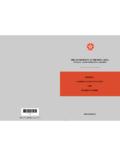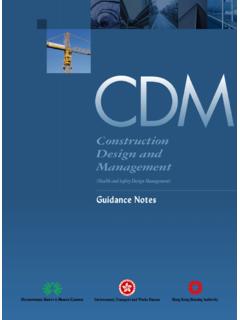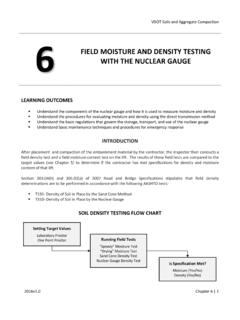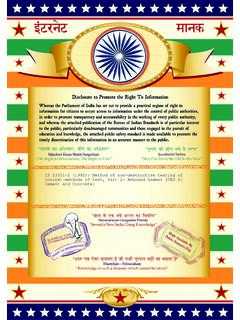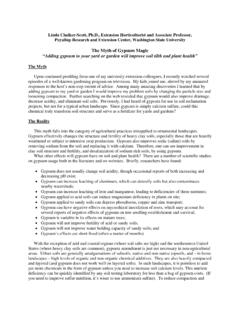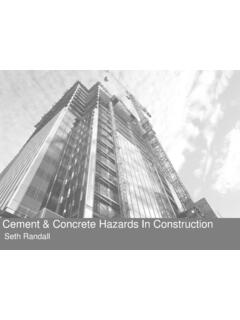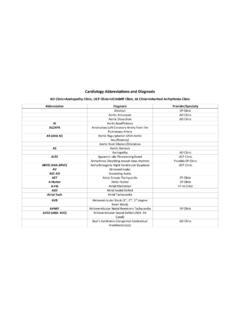Transcription of Acceptance testing and criteria for ready mixed concrete ...
1 1 Acceptance testing and criteria for ready mixed concrete in Hong Kong Al bert Kwan and Isaac Ling Department of Civil Engineering The University of Hong Kong 2 Outline Introduction Producer s Risk and Consumer s Risk Review on Standards for Acceptance testing and criteria Effect of Target Mean Strength on Producer s Risk Effect of Workmanship on Cube Compressive Strength and Density Experimental Program Results and Discussions Concluding Remarks and Recommendations 3 concrete Complex materials made of Aggregates particles Cementitious materials Chemical admixtures Polymer latex or bituminous emulsions Various kinds of fibres Difficulties in controlling the quality of concrete produced Batch-to -batch variations Within-batch / Within-test variations 4 Measurement of variation Mean strength Standard deviation Coefficient of variation xc v=5 Producer s Risk and Consumer s Risk Producer s Risk Rejection of concrete that is up-to -standard Higher cost price Consumer s Risk Acceptance of concrete that is sub -standard Stringent Acceptance criteria 6 Review on Standards for Acceptance testing and criteria of concrete Foreign codes American Standard ACI 214R-11 European Standard BS EN 206: 2013 Local codes Code of Practice for Structural Use of concrete : 2013 General Specification for Civil Engineering Works: 2006 Construction Standard CS1: 2010 7 ACI 214R-11 Specimens for each test result: 2 concrete cylinders of 150 300 mm or.
2 3 concrete cylinders of 100 200 mm Evaluation of standard of quality control through: Standard deviation Coefficient of variation (see Table and Table ) 8 Table f cube= MPa 9 Table f cube= MPa 10 Estimation of standard deviation or coefficient of variation A minimum of 30 test results Conservative approach required when test results < 30 ACI 318 allows a minimum of 15 test results the sample standard deviation should be increased by up to 16% to account for greater uncertainty in the estimated population standard deviation 11 Acceptance criteria Acceptance criteria Average of required st rength not exceeding the specified strength by a certain multiple of the standard deviation, as given in table 12 BS EN 206: 2013 Acceptance testing and criteria are give in Section Clause Test result = individual specimen OR the average of test values from two or more specimens from one sample tested at same age Disregard the test result when range of test values > 15% of the mean Calculation of standard deviation Most recent 35 consecutive test results No maximum limit 13 Acceptance criteria Given in Clause test result > (Specified grade strength 4) MPa 2a.
3 In initial production (until 35 test results are obtained) Mean strength of 3 consecutive results (Specified grade strength + 4) MPa 2b. In continuous production (when 35 test results are available) Mean strength of the consecutive test results (Specified grade strength + standard deviation MPa 14 Standards in Hong Kong Acceptance criteria Code of Practice for Structural Use of concrete : 2013 General Specification for Civil Engineering Works: 2006 testing method Construction Standard CS1: 2010 15 Code of Practice for Structural Use of concrete : 2013 Acceptance testing and criteria given in Clause Clause 2 cubes shall be made in accordance to CS1 Test result = average compressive strength of the pair of cubes Disregard test result when difference > 20% of test result Calculation of standard deviation 40 consecutive test results 16 Acceptance criteria 17 Non-compliance circumstances Suspension of concrete production and concreting For concrete grade < C60, Cubes of 150 mm standard deviation > MPa Cubes of 100 mm standard deviation > Mpa Fo r concrete grade > C60, coefficient of variation > 14% 18 General Specification for Civil Engineering Works.)
4 2006 Acceptance testing and criteria given in Clauses to Clause 2 cubes shall be made in accordance to CS1 Test result = average compressive strength of each pair of cubes made from the sample Disregard test result when difference > 15% of test result concrete cores might be necessary if the Acceptance requirements are not satisfied Calculation of standard deviation 40 consecutive test results 19 Acceptance criteria 20 Non-compliance circumstances Suspension of concrete production and concreting Cubes of 150 mm standard deviation > MPa Cubes of 100 mm standard deviation > Mpa 21 Comparison Standards ACI 214R-11 BS EN 206: 2013 Code of Practice for Structural Use of concrete 2013 General Specs. For Civil Engineering Works: 2006 Specimens Cylinder Cube / Cylinder Cube Cube Maximum allowable range of difference Nil 15% 20% 15% Calculation of standard deviation OR coefficient of variation 30 test results required 35 test results required 40 test results required 40 test results required Limit imposed on standard deviation OR coefficient of variation No No Yes (Table ) Yes (Table ) Different requirements 22 Construction Standard CS1: 2010 Guidelines for sampling and testing method in Hong Kong Specimens concrete cubes of 150 mm or 100 mm Section 7 Method of making test cubes Section 12 Test methods for determining compressive strength Section 16 Test methods for determining density 23 Section 7 (Making test cubes) Fresh concrete shall be placed in the mould in layers approximately 50 mm deep each layer shall be compacted either by using.
5 - compacting bar - vibrating The minimum number of strokes per layer required to produce full compaction will depend upon the workability of the concrete Not less than 35 strokes per layer for 150 mm cubes Not less than 25 strokes per layer for 100 mm cubes except in the case of very high workability concrete . During the compaction of each layer by means of vibration, the applied vibration shall be of the minimum duration necessary to achieve full compaction of the concrete Cease as soon as the surface becomes smooth and air bubbles cease to appear. 24 Section 12 (Determining compressive strength) Cubes shall be tested with the trowelled surface vertical and with the loading applied to moulded surfaces steadily at a certain loading rate No capping is required and thus the test method is applicable to both normal-st rength concrete and high-strength concrete testing of cylinders capped at the end surfaces is not applicable to high-strength concrete 25 Section 16 (Determining density) Methods Direct measurement method Water displacement method (preferred)
6 Differ in measurement of volume Direct measurement method Volume is calculated through measured dimensions of the cubes Water displacement method Volume is determined through volume of water displaced when immersed in water 26 Effect of Target Mean Strength on Producer s Risk Acceptance criteria is governed by the limits imposed on standard deviation or coefficient of variation, not characteristic strength Root cause of relatively high producer s risk in Hong Kong Reducing Producer s Risk Raising the target mean strength such that the expected characteristic strength is at least 5%-10% higher than the specified concrete grade Higher cost of construction Larger carbon footprint Actual effect of raising target mean strength is not evaluated Monte Carlo simulation is suggested for the evaluation 27 Effect of Workmanship on Cube Compressive Strength and Density Experimental program of casting concrete cubes with different amounts of compaction applied To investigate Effect of compaction effort on the 7 days and 28 days compressive strengths Effect of compaction on effort on the 7 days and 28 days density measured by methods stipulated in CS1: 2010 28 Materials Ordinary Portland cement Strength class complying with BS EN 197-1.
7 2000 Superplasticizer (SP) Polycarboxylate-based Fine and coarse aggregate Local crushed granite rocks Fine aggregate : aggregate with maximum size of 5 mm Coarse aggregate : comprised of 10 mm maximum size and 20 mm ma ximum size aggregate 29 Design of Experiment Water/cement (W/C) ratio = Fine to total aggregate ratio = 10 mm to 20 mm aggregate ratio = SP dosage = litre/m3 Different slump values Paste volume = 26% (measured slump value = 30 mm) Paste volume = 30% (measured slump value = 180 mm) 30 Experimental works Mixing of materials by pan mixer 1 min of mixing for all materials except water and SP 3 min of mixing after addition of water and SP Measurement of slump value by slump test In accordance to procedures stipulated in BS EN 12530-8: 2010 Casting of twenty-four 100 mm cubes with different compaction efforts Curing of specimens Lime -saturated water tank at temperature of 27 2 oC 31 compaction effort Group compaction effort 1 Poker vibrator 2 30 strokes per layer 3 5 strokes per layer 4 0 stroke per layer 32 Tests performed Tests at 7-day and 28-day Measurement of densities Measurement of compressive strength Measurement of densities, through : Direct measurement method (geometric dimensions) Water displacement method Procedures carried out in accordance with Sections 12 and 16 of Construction Standard CS1.
8 2010 33 Experimental Results 34 Test results of concrete mix with W/C = and measured slump = 30 mm 35 Test results of concrete mix with W/C = and measured slump = 180 mm 36 Density by direct measurement method versus compaction effort applied (for concrete mix with measured slump = 30 mm) 37 Density by water displacement method versus compaction effort applied (for concrete mix with measured slump = 30 mm) 38 7- day and 28-day cube strengths versus compaction effort applied (for concrete mix with measured slump = 30 mm) 39 Density by direct measurement method versus compaction effort applied (for concrete mix with measured slump = 180 mm) 40 Density by water displacement method versus compaction effort applied (for concrete mix with measured slump = 180 mm) 41 7- day and 28-day cube strengths versus compaction effort applied (for concrete mix with measured slump = 180 mm) 42 Observations The compaction effort has significant effects on the density measured by direct measurement method or water displacement method The effects are larger for the concrete mix with slump = 30 mm and smaller for the concrete mix with slump = 180 mm The compaction effort has significant effects on the 7-day and 28-day cube strengths The effects are larger for the concrete mix with slump = 30 mm and smaller for the concrete mix with slump = 180 mm 43 Average of density results versus compaction effort applied 44 Average of 7-day strength results versus compaction effort applied 45 Average of 28-day strength results versus compaction effort applied 46 Summary (1) The compaction applied has significant effect on.
9 The density of the concrete cube specimen especially if the concrete has a low workability The effect on the density measured by direct measurement method is larger than that on the density measured by water displacement method The note in Section 16 of CS1 that determination of the volume by water di splacement is to be preferred needs to be reviewed It is suggested herein that the direct measurement method is a better and mor e sensitive method for checking the quality of compaction applied during cube making. 47 Summary (2) The compaction applied has significant effect on: the compressive strength of the concrete cube specimen especially if the concrete has a low workability Difference in strengths of a pair of cubes made from same sample can be 15- 20% concrete cubes in the pair are with bad workmanship Have fairly low strengths and the bad workmanship may not be ref lected in difference in strengths Can be reflected in density measured by direct measurement method.
10 48 Concluding Remarks Remarks: ACI 214R-11 Provides good background to Acceptance testing and criteria of con crete BS EN 206: 2013 More scientific and systematic Code of Practice for Structural Use of concrete : 2013 and General Specification for Civil Engineering Works: 2006 Review on inconsistencies and preferably unify them Construction Standard CS1: 2010 Review on test methods for density measurement 49 Recommendations (1) Reduction of test results in estimation of standard deviation: 40 35 test results (BS EN 206: 2013) Benefits: Standard deviation and characteristic strength of the concrete production can be obtained at earlier time Faster response time and implementation of corrective actions 50 Recommendations (2) Disregard test result if the difference exceeds 10%, in calculation of: i. Mean cube strength ii. Batch-to -batch variation iii.

